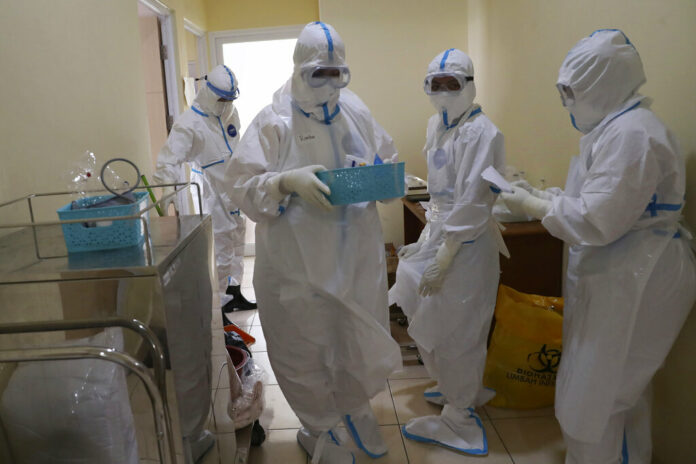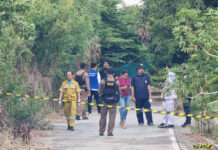
JAKARTA, Indonesia (AP) — Irman Pahlepi is back at work in Jakarta’s Dr. Suyoto public hospital, immediately resuming his duties treating COVID-19 patients after recovering from an infection himself — for the second time.
With numbers of infections in Indonesia skyrocketing and deaths steadily climbing, health care workers are being depleted as the virus spares nobody, Pahlepi, 30, felt he had no option but to jump right back in.
“We have so many extra patients to treat compared to last year,” he said. “The number of COVID-19 patients is four times higher now than during the previous highest spike in January.”
Indonesia, the world’s fourth most populous country, had its deadliest day with 2,069 deaths from COVID-19 last Tuesday and fatalities remain high. As of Sunday, total official cases stood at more than 3.4 million with 97,291 deaths, though with poor testing and many people dying at home, the real figures are thought to be considerably higher.
As the region grapples with a new coronavirus wave fueled by the delta variant, Indonesia’s death rate hit a 7-day rolling average of 6.5 per million on Aug. 1, second only to Myanmar and far higher than India’s peak rate of 3.04 that it hit in May during the worst of its outbreak.
Among the dead in Indonesia are more than 1,200 health care workers, including 598 doctors, according to the Risk Mitigation Team of the Indonesian Medical Association. The doctors included at least 24 who were fully vaccinated.
Many others are exhausted from the workload, said Mahesa Paranadipa, who co-leads the mitigation team, making them more likely to fall ill, like Pahlepi.
“We are worried about overburdened workloads lasting for a long time, causing potential burnout conditions,” Paranadipa said. “This fatigue causes the immunity of health care workers to decrease.”
Acknowledging the risks faced by health care workers, Health Minister Budi Gunadi Sadikin said Monday that a top priority is giving them a third booster vaccine dose. Most who have been vaccinated have received Sinovac, which appears to be less effective against the delta variant, and Indonesia has already begun administering booster shots.
“The boosters, from Moderna, are for health care workers … so they will be ready for the patients at the hospitals,” Sadikin said.
On top of the lack of medical personnel, Indonesia is also suffering from inadequate supplies.
Pahlepi said his hospital experiences oxygen shortages and is filled far beyond its patient capacity, making it even more difficult to treat people properly.
Over the last two months, it has become common to see dozens of people with severe symptoms waiting in line for a bed in the hospital’s emergency unit, and more lines of people waiting for a space in the isolation ward following treatment, he said.
Some patients have brought their own oxygen tanks with them, and as the hospital’s own supplies have waned, doctors and nurses have had to ask them to share with others.
Last year, most of the severely ill patients Pahlepi saw were senior citizens. Now, as the delta variant spreads through the country, most of the patients arriving at the emergency room with medium and severe symptoms are children and young adults, he said.
Between his own coronavirus infections, Pahlepi and his wife had their first child — a daughter who is now 5 months old — and he said it’s been particularly hard as a new father to see so many children admitted for treatment with relatively severe symptoms.
“It is difficult to help the infants put on an oxygen hose because they feel uncomfortable when an unfamiliar object is on their face. They need their parents to be with them when we put on the hose,” Pahlepi said.
“Those infants remind me of my baby daughter at home. It makes me sad.”
Pahlepi has been involved in treating coronavirus patients since the beginning of the pandemic, starting as a COVID-19 intake doctor at Gatot Soebroto Army Central Hospital, which was designated by the government as a referral hospital for the disease.
In November, he tested positive himself despite taking precautions. Fortunately, his case was mild and he was able to return to work after recovering in isolation for two weeks.
He tested positive again on July 14 while working extra shifts to help cope with the influx of patients in the recent surge — just one week before he was to receive his first vaccination.
While he was asymptomatic during his first infection, he had severe headaches and his bones ached during the second.
Like many of his patients, he decided to isolate at home. But unlike most, with his training he was able to keep a careful eye on his health, ensuring that his blood oxygen level was adequate and that he didn’t need more advanced treatment.
“There are so many people with heavier symptoms who deserve beds in the hospital more than me,” Pahlepi said in a video interview as he was in isolation.
As soon as he was better, Pahlepi went right back to help his overworked colleagues.
“The emergency unit was full, and we were overwhelmed handling COVID-19 patients,” he said. “The number of patients is beyond our capabilities. We have to use 200% to 300% of our energy every shift.”
Though there is no end in sight for the current wave in Indonesia, Pahlepi’s thoughts are regularly of the day when life returns to normal for his young family and the rest of the country.
“I feel tired — exhausted — but we have to keep our spirits up to make Indonesia successfully free from COVID-19,” he said.
Story: Edna Tarigan















































